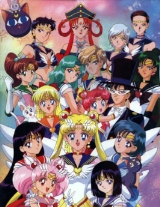
Sailor Moon
Overview
Sailor Moon, known as , is a media franchise
created by manga artist
Naoko Takeuchi
. Fred Patten
credits Takeuchi with popularizing the concept of a team of magical girl
s, and Paul Gravett
credits the series with "revitalizing" the magical-girl genre
itself. Sailor Moon redefined the magical-girl genre, as previous magical girls did not use their powers to fight evil, but this has become one of the standard archetypes of the genre.
The story of the various metaseries revolves around the reborn defenders of a kingdom that once spanned the solar system
, and around the evil forces that they battle.
Media franchise
A media franchise is an intellectual property involving the characters, setting and trademarks of an original work of media , such as a film, a work of literature, a television program or a video game. Generally, a whole series is made in a particular medium, along with merchandising and endorsements...
created by manga artist
Mangaka
is the Japanese word for a comic artist or cartoonist. Outside of Japan, manga usually refers to a Japanese comic book and mangaka refers to the author of the manga, who is usually Japanese...
Naoko Takeuchi
Naoko Takeuchi
is a Japanese manga artist who lives in Tokyo, Japan. Takeuchi's works have a wide following among anime and manga fans worldwide. Her most popular work, Sailor Moon, rose to become one of the most recognized manga and anime products to date.-Early life:...
. Fred Patten
Fred Patten
Frederick Walter Patten is known for his work as a historian in the science fiction, anime, manga, and furry fandoms, where he has gained great distinction through a substantial contribution to both print and online books, magazines, and other media....
credits Takeuchi with popularizing the concept of a team of magical girl
Magical girl
belong to a sub-genre of Japanese fantasy anime and manga. Magical girl stories feature young girls with superhuman abilities, forced to fight evil and to protect the Earth. They often possess a secret identity, although the name can just refer to young girls who follow a plotline involving magic...
s, and Paul Gravett
Paul Gravett
Paul Gravett is a London-based journalist, curator, writer and broadcaster who has worked in comics publishing and promotion for over 20 years....
credits the series with "revitalizing" the magical-girl genre
Genre
Genre , Greek: genos, γένος) is the term for any category of literature or other forms of art or culture, e.g. music, and in general, any type of discourse, whether written or spoken, audial or visual, based on some set of stylistic criteria. Genres are formed by conventions that change over time...
itself. Sailor Moon redefined the magical-girl genre, as previous magical girls did not use their powers to fight evil, but this has become one of the standard archetypes of the genre.
The story of the various metaseries revolves around the reborn defenders of a kingdom that once spanned the solar system
Solar System
The Solar System consists of the Sun and the astronomical objects gravitationally bound in orbit around it, all of which formed from the collapse of a giant molecular cloud approximately 4.6 billion years ago. The vast majority of the system's mass is in the Sun...
, and around the evil forces that they battle.
Quotations
Usagi: Moon Prism Power, Make-Up! (First transformation phrase.)![]()
Sailor Moon: Moon Tiara Action! (First attack.)
--------------------------------------------![]()
Sailor Moon: I am Sailor Moon, champion of justice! On behalf of the moon, I will right wrongs and triumph over evil, and that means you!![]()
Inital dubbed version
--------------------------------------------
From the English dubbed version, Episode 4 (Episode 7 in Japan), "So You Want to Be a Superstar." Usagi Tsukino|Serena (Usagi) and Molly (Naru) are singing and dancing to the Sailor Moon theme song - very badly - in Usagi's room when Usagi's brother Sammy (Shingo) bursts in.
Shingo: Hey, are you guys trying to torture me?!![]()
Usagi: Go away, you're interrupting our rehearsal!![]()

